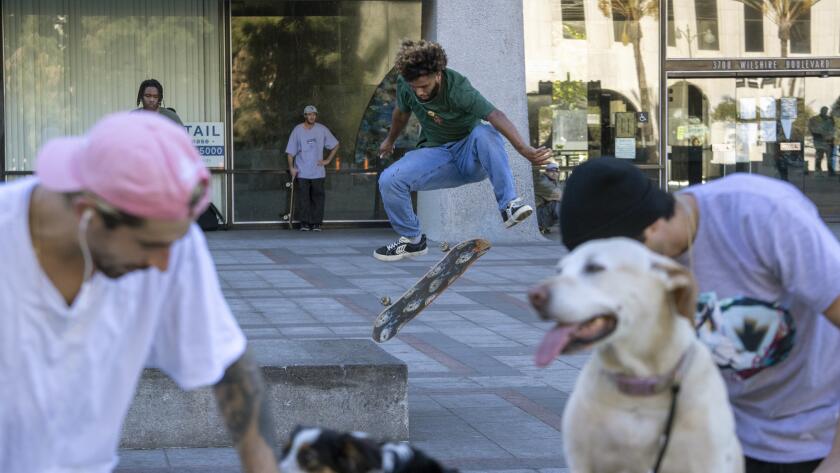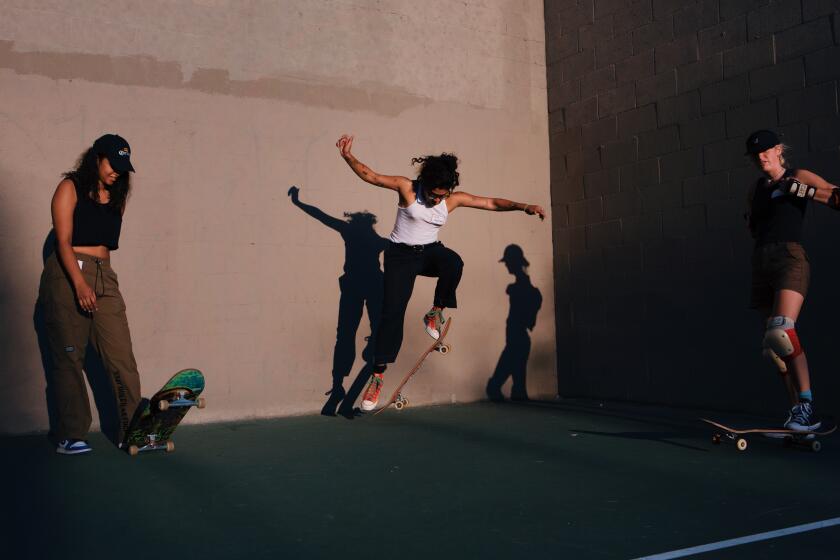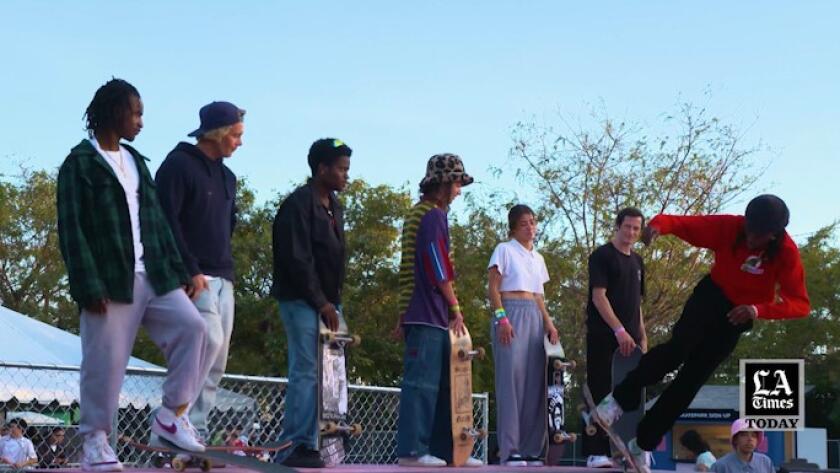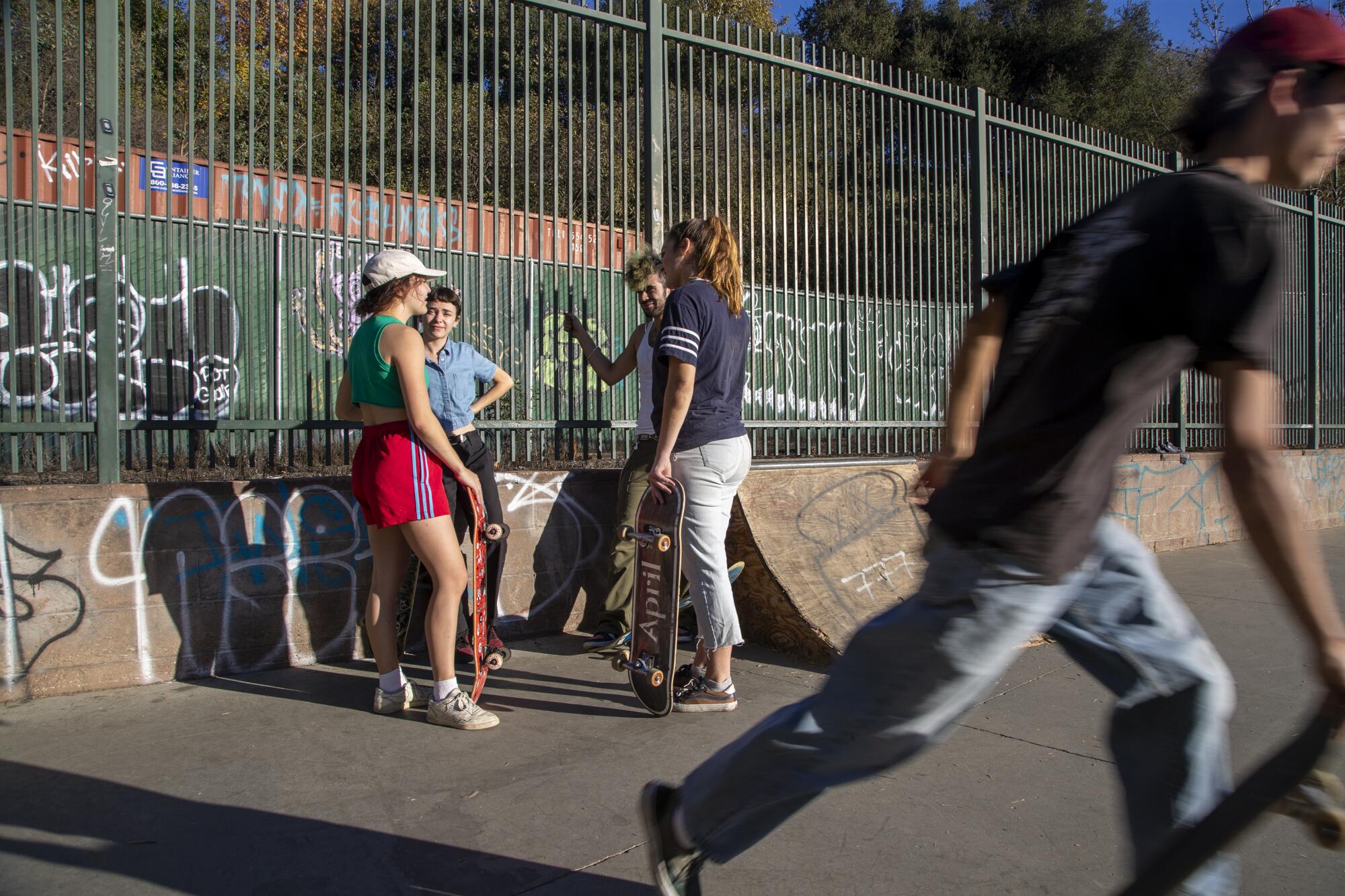
- Share via
The women keep their distance. At first. Dressed in T-shirts and sneakers, skateboards in hand, they stand by a chain-link fence, talking, laughing, waiting to make their move.
The Aunt Skatie crew, as they call themselves, has traveled east of downtown Los Angeles to convene just outside a community skate park outfitted with all manner of concrete stairs, banks and ledges for doing tricks. On a gray Sunday morning, they can see the space is filled mostly with guys.
Killing a few minutes on an adjacent tennis court, the women ride in lazy circles as a portable speaker blasts rap music, its heavy beat mixing with the scuffle of urethane wheels. One of the men inside the park stops to peer through the fence at them; Maggie Bowen, the Aunt Skatie leader, is used to this.
“Going into a skate park as a woman can be kind of intimidating,” she says. “Especially if you’re a beginner, guys look at you weird.”
- Share via
Their sport is not immune to cultural issues of race, gender and sexual orientation, but Bowen says “for women and queer people, it’s easier if you skate as a group.” And the increasing popularity of crews like hers has sociologists wondering if skaters might teach the rest of us something about inclusivity.
The Tokyo Olympics helped show the world that skating is not just for white kids in the suburbs. People of color have risen to the highest levels of competition and the vibe is distinctly urban, fueled by hip-hop music and street fashion. Now more women and the LGBTQ community are joining in.
“No one owns skateboarding, it is not made up of institutions that formulate policies,” says Neftalie Williams, a USC scholar and visiting fellow at Yale. “It just happens organically with people who come together to do this thing they love.”
Skating legend Tony Hawk calls it “safety in numbers.”
The recent Aunt Skatie meet-up puts this notion to a test as the crew ventures — a bit nervously — inside El Sereno Skate Park. This might be the best way to understand the culture, through tales of people and places around Southern California, the birthplace of skateboarding.
The Scholar
The kid noticed something different. Growing up in Massachusetts — years before he became an academic — Williams saw that skateboarding didn’t have rules or coaches like Little League and youth soccer.
“Nobody was in charge,” he recalls. “It was just everyone deciding they wanted to learn this thing on their own.”
Becoming an avid skater in his teens, Williams attended USC, in part because Southern California weather allowed for more days outside on his board. Public diplomacy classes got him viewing his passion through a different lens.
SoCal's skateboarding connection
No sport is more connected to Southern California than skateboarding. Here’s a look at the people who have helped the sport thrive and become part of SoCal’s cultural identity.
If you showed up at a skate park or a street spot with a new trick, or merely an eagerness to learn, strangers tended to accept you. Cooperation was the best way to improve and this, he realized, fostered diversity.
“Young people were building communities,” he says. “It was such a great way to be social as an individual or a collective.”
By then, the sport had experienced a series of evolutions in its relatively brief history. Surfers started the whole thing around the 1950s, looking for something to do when the ocean lay flat. Downhill cruising morphed into trick riding inside empty pools and skate parks and big jumps off vert ramps. The 1990s brought a return to the streets with an emphasis on using curbs and stairs as props.
People of color had long been part of the scene in small numbers — Williams recalls Black kids, whites and Latinos skating together in his hometown — but Hawk says urbanization supercharged this dynamic: “That’s where you saw more kids from different backgrounds.”
Black people and Latinos now account for nearly a third of an estimated 9 million skaters in the U.S., according to Sports Marketing Surveys, an international research agency. The number of female skaters has similarly risen to about 2.7 million and an estimated 7.4% of respondents who identify as LGBTQ are skateboarders.
This diversity has brought more attention to the work Williams and his colleagues are doing at USC. Their 2019 survey of nearly 6,000 skaters nationwide found that race, gender and sexual orientation don’t seem to matter as much when kids skate.
With his dreadlocks and perpetually excited demeanor, Williams is writing a book on “skateboard diplomacy” and working with the Smithsonian Institution to bolster its archives on the sport. He believes the more we know about skating, the more we can build inclusion into all types of shared environments.
“Skaters are working through the problems of the world.”
The Explorer
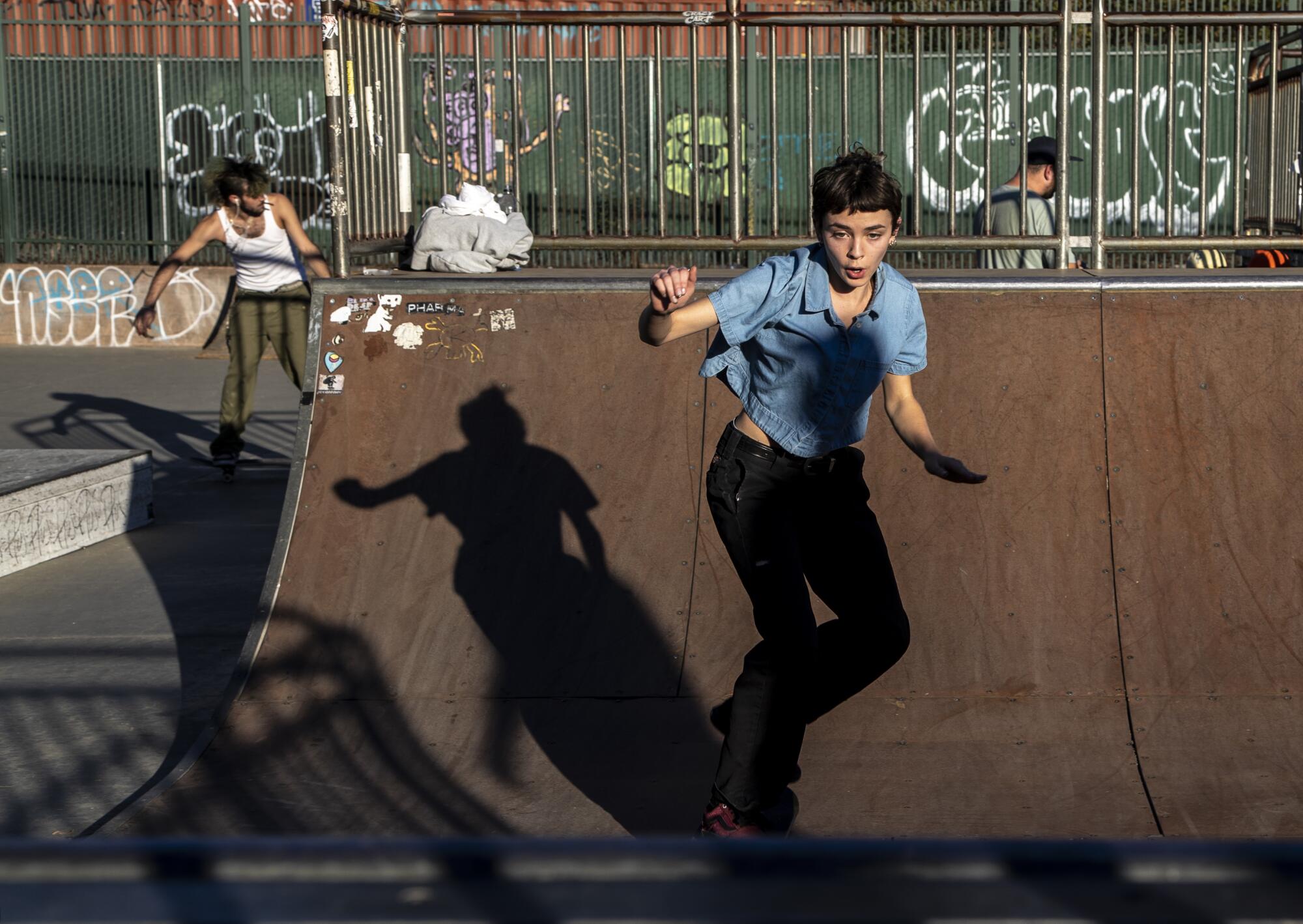
Before Tony Alva made a name for himself as a Latino member of the famed Z-Boys, before Nyjah Huston became a Black superstar on the pro circuit, Marty Grimes was a kid getting up early on Saturday mornings, leaving his Midtown home to go exploring.
It was the early 1970s and there weren’t many skaters of color like him. Grimes, his brother and some friends would catch a bus to West Los Angeles, then start pushing up Bundy Drive. They embodied a fundamental truth in skating: Mobility equals diversity.
The same boards used for tricks also serve as transportation from one spot to another, a way for kids of different ethnicities and socioeconomic backgrounds to interact.
In those days, skaters wanted to emulate the feel of surfing, looking for gently curved banks that could be ridden like concrete waves. This suited Grimes, who learned to surf at an early age but switched sports because he had no reliable transportation to the beach.
Old photographs show him as a spindly teenager in T-shirt and shorts, crouched super low on his board, carving graceful cutbacks. He and his crew would start in Brentwood, switch to Kenter Canyon Elementary and then to Bellagio Road Elementary School across the 405 Freeway.
“We were going to neighborhoods where the adults didn’t want to see us,” Grimes says. “Grown men would be leaning out of their cars, saying ‘Hey, n-word, get the hell out of here.’”
White skaters often were surprised to see Black kids roll up but treated them well enough, especially when Marty and Clyde Grimes showed their stuff. Marty recalls: “They were like, ‘These guys are ripping. Let’s see what they can do so we can do it too.’”
Jay Adams, a star in those days, spotted the brothers riding outside the Santa Monica Civic Auditorium and recruited them for his pro team — an unusual move in a sport dominated by whites at the time.
Fifty years later, Grimes is a member of the Skateboarding Hall of Fame and founder of HoodWood skateboards, one of a growing number of Black-owned businesses in the industry. He thinks back to those formative years, a weekend routine that included stopping along Sunset Boulevard and at Paul Revere Middle School, then circling back to Pico Boulevard for the bus home.
“Nothing could stop us,” he says. “We just kept skating and skating and our world kept getting larger and larger.”
Church in Session
- Share via
JKwon is a community of skateboarders that welcomes one and all.
You can hear it from a block away, the echo of rattling wheels and thwacking boards, shaking Koreatown’s drowsy streets on a Sunday morning.
Skaters flock to this plaza in front of an office building because of its checkerboard of granite ledges — like planter boxes without foliage — perfect for grinding. The official name is Liberty Park but regulars call it “JKwon.” Or, more simply, church.
“This is it,” Don Cooley says. “You have reached the spot.”
Standing beside the plaza, dressed in a stylish black-and-red sweatsuit, Cooley serves as unofficial host. With specks of gray in his beard and a tiny skateboard tattooed above his right eyebrow, he welcomes new arrivals, trading jokes and stories.
“There’s enough room for everybody,” he says, with a sweep of his arm. “You can pick up a board and start skating around and you are part of it.”
This is another of the sport’s advantages — boundless resources.
As these photos show, new friends are made, camaraderie is built and sometimes the bonds become the genesis for new meet-ups, new skate crews to be born.
Pick-up basketball players must win to stay on court and surfers compete for a finite number of good waves. With countless parking lots and school yards and public squares at their disposal, skaters face no such limitations. Though Hawk’s Skatepark Project has raised more than $10 million to build hundreds of skate parks across the country, he says, “The urban landscape can be a skate park. You can do it anywhere.”
For every spot that might be crowded or guarded by territorial locals, there are a dozen more nearby. Most skaters observe an unwritten etiquette, taking turns on ledges and ramps. Beginners ride the easy sections, leaving the tougher stuff to veterans.
That is how it works at JKwon.
The spot has been popular for decades because of its embarrassment of riches, all those ledges and a few gentle ramps and curved columns for wall rides. The property owners cracked down for a while, but things opened up during the coronavirus shutdown.
Now, the action begins early, everyone hoping to clock a few hours before security guards arrive to shoo them away at noon. The crowd is diverse, including a few women and a transgender regular. “Nobody messes with him,” Cooley says. “It’s all love.”
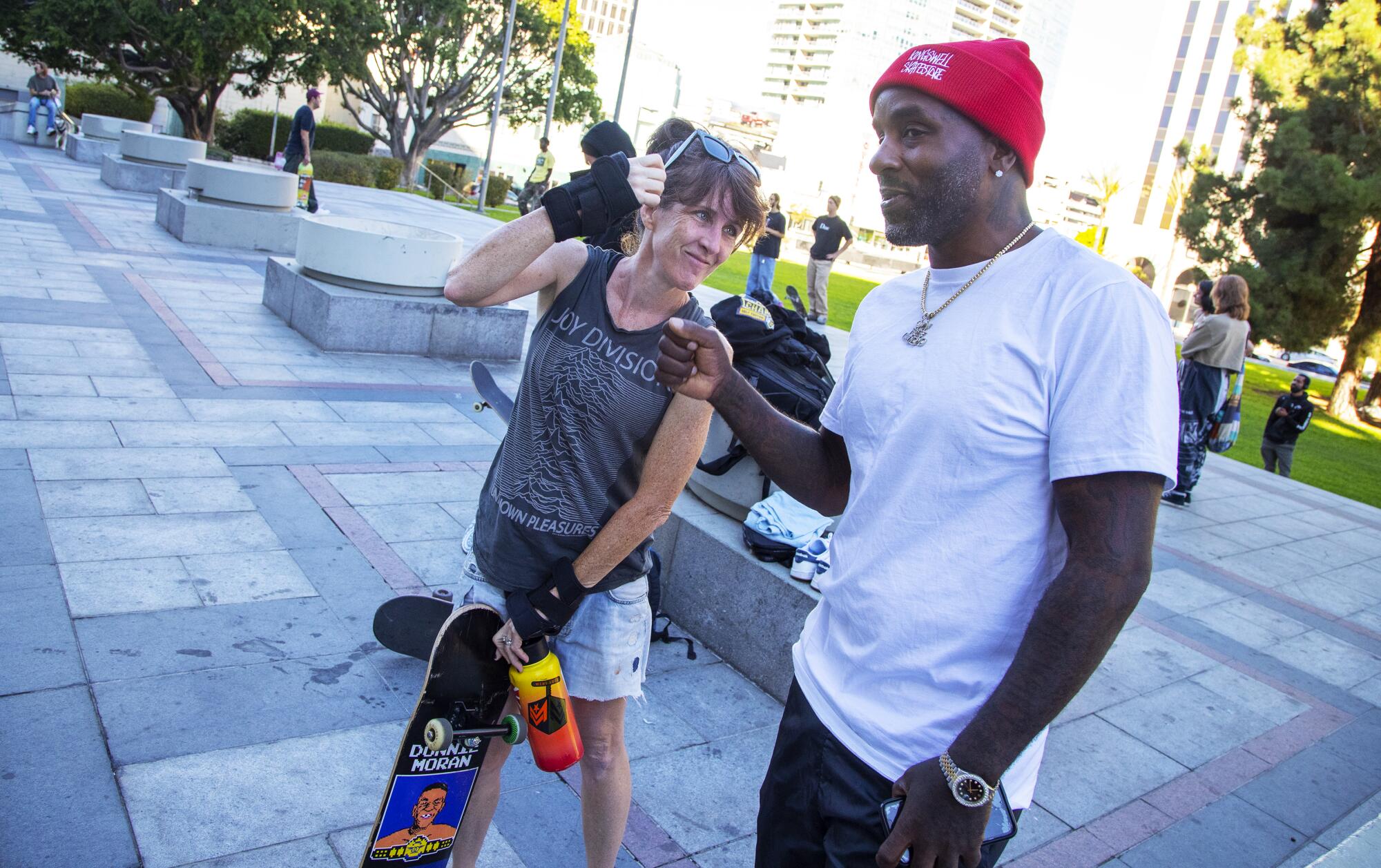
As team manager for DGK, a skateboard brand whose name is short for “Dirty Ghetto Kids,” the 43-year-old carries enough weight to keep everyone in line, talking rapid-fire, punctuating his thoughts with a quick laugh or tap on the shoulder.
“Nobody has to fight over a ledge they want to skate; it ain’t going anywhere,” he says. “Of course we get some jerks, but we also have people like me, so they get scolded.”
The rules are important to a man who showed promise as a young skater, then fell into trouble with the law and served prison time. Returning to the sport, he says, “literally saved my life.” When security guards come on duty, he urges skaters to leave without a fuss.
“Treat people like you want to be treated,” he says. “I get the security coffee at Starbucks. Oh, you want a latte this morning?”
The Teacher
It took awhile before the boys let a girl skate with them. Briana King was 12 years old, skinny and inexperienced, but obsessed with riding a board she got at a swap meet. Eager to prove “valid enough,” she took on a set of stairs.
“Broke my leg,” she says.
That pretty much ended her first try at skating.
In the decade that followed, her willowy figure and striking looks led to a career in modeling, taking her from Boyle Heights to Australia, then New York. She fell in with a group of friends — other Black women — who coaxed her back onto a board after 12 years away.
“I was scared of the experience boys had given me,” King says. “Then I saw people like me and thought, ‘OK, here’s my time.’”
Within a year, a major skateboard company was paying her to travel the country and hold clinics for women and LGBTQ skaters, most of them beginners.
“I just tell them that we’re in a safe place when we’re together,” she says.
Skateboarding in the U.S. has been dominated by white dudes. Lately women, people of color and LGBTQ people are creating room for themselves.
This new chapter in her life owes to yet another development in skating — the influence of social media and the “meet-up.”
In a sport where online content is king, YouTube and Instagram are crucial in giving skaters a chance to post videos, get seen and attract sponsors. For people of color, women and the LGBTQ community, these outlets serve an additional role.
Underrepresented skaters can find each other, arrange meetings and form crews. At Skate Like a Girl, a West Coast-based
nonprofit, executive director Kristin Ebeling says fledgling groups can quickly accomplish what used to require years of networking and publicizing. “Throw a couple of hashtags on it and, right there, you can connect with 100 people in your community,” she says.
A few shy, nervous beginners usually show up at King’s sessions and she gravitates toward them, happy to start slowly, holding their hands as they grow accustomed to standing on a board.
Some old-timers complain about skipping a rite of passage — the awkward, frightening part of starting alone. But the sport is still grappling with misogyny and reports of sexual assault in the pro ranks. Meet-ups have helped nurture diverse crews such as Board 2 Tears and GRLSWIRL in Los Angeles, froSkate in Chicago and the Skate Kitchen in New York.
The new way suits King, who learned to use Instagram in her modeling career. Seeking to attract women and LGBTQ skaters, she asked skateboard companies for funding and went online to promote her meet-ups.
“There are usually like 60 people minimum,” she says. “The majority feel very comfortable being around women and nonbinary or queer people.”
This sense of security works both ways. Though King’s repertoire now includes enough tricks to hang around the pros, she feels jittery when skating on her own, especially if she is the only Black woman.
“I need a bigger gang of friends,” she says. “I’ll have more girls to skate with.”
Aunt Skatie
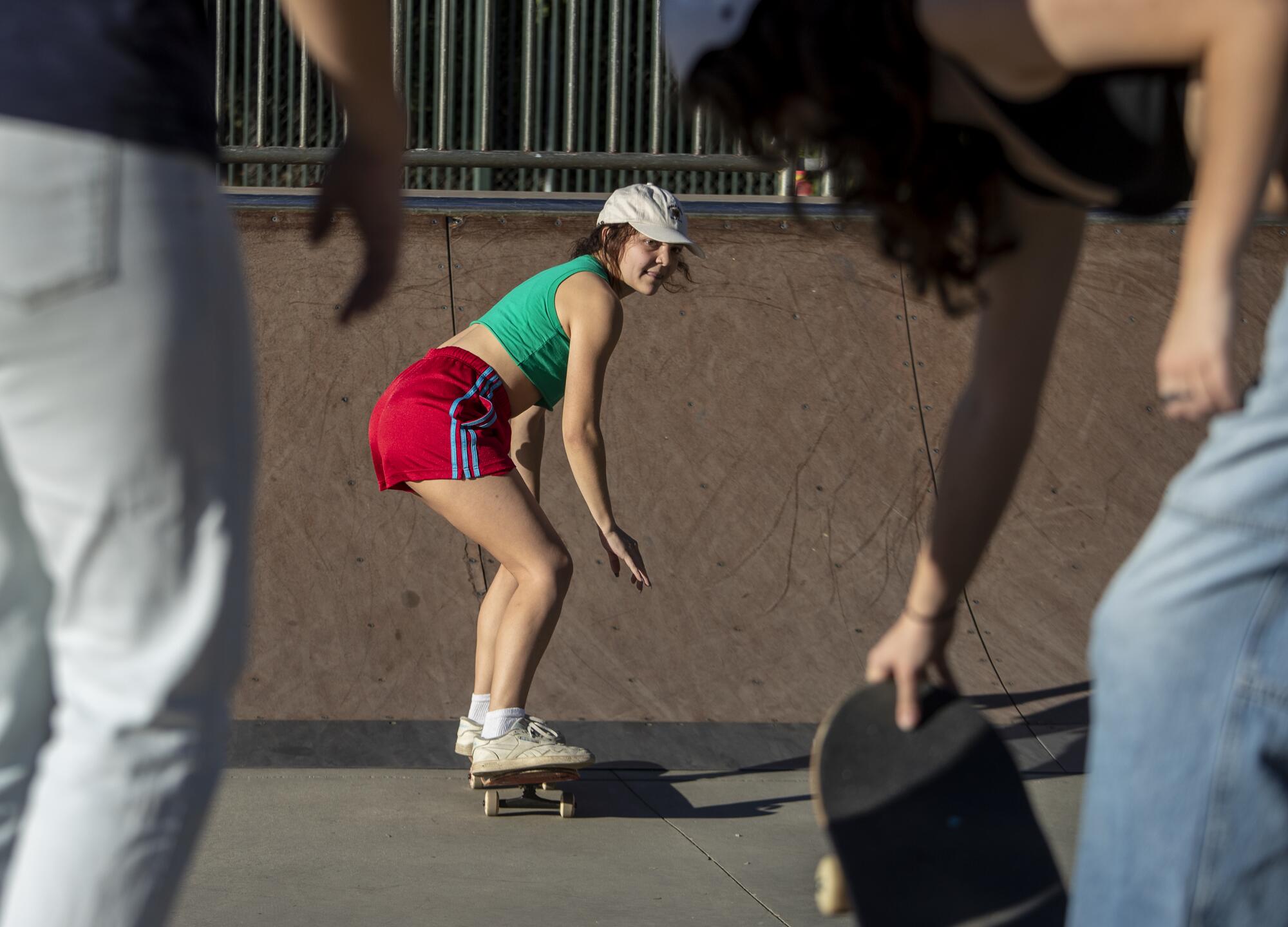
The Aunt Skatie crew files through a gate in the chain-link fence, leaving the tennis court behind and entering the El Sereno Skate Park. Bowen asks them: “What’s your goal for today?”
The 22-year-old began skating as a teenager in Michigan — “I’d bomb the hills in my neighborhood” — and needed a new crew at USC. She decided to start her own, handing out fliers, posting invitations on social media, even chasing down other women who rode their boards on campus.
Many of the Aunt Skatie members are beginners, sticking to basics at first, riding flat spaces and easy obstacles. Isabelle Sherman ponders trying the perimeter, negotiating the up-and-down of ramps in each corner.
“I’m probably overthinking this,” she says.
Bowen tells her: “You’ve definitely got the vibe.”
“It’s just so much harder than it looks.”
“OK,” Bowen says. “I’m going.”

No one pays much attention as the pair works on technique, and that’s a good thing. For women, dirty looks from men are not the only bad part about skating alone; there’s also the unsolicited advice. Lily Alonso says some guys “try to slide in and make conversation in a flirty way. Or they start mansplaining.”
The different factions at El Sereno keep to themselves initially, falling into a quiet, familiar rhythm. Groups stand along the edge, waiting for a chance to go, then do their tricks and reconvene at the other side.
But as time passes, they begin to interact. Someone yells “Nice!” in response to a well-executed trick. Someone else needs to borrow a tool to adjust the trucks on their board. People start chatting.
“It’s friendly,” Alonso says. “It’s honest.”
By early afternoon, gray skies have turned blue and El Sereno is crowded. The temperature is just warm enough that everyone works up a good sweat.
The Aunt Skatie crew has logged a couple of hours and some are getting tired. Bowen and Sherman don’t want to leave just yet. They make a few more runs, navigating those ramps, growing more confident with each loop around the park.
- Share via



